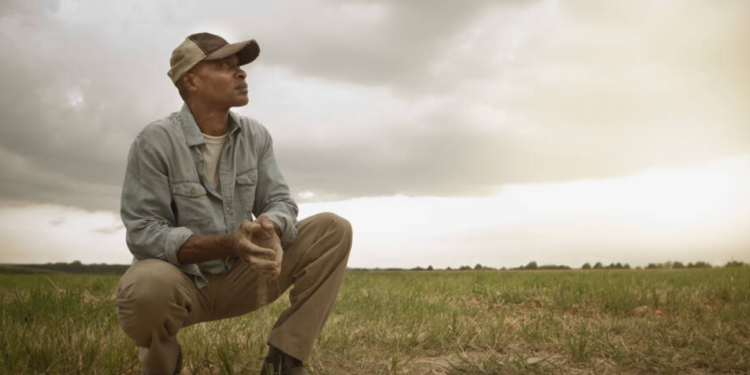Sep 23, 2024 Story by: Editor
In Tatums, Oklahoma, a historic All-Black town, the Mary T. Tatums Municipal Building stands alongside State Highway 7. Inside, Bonnie Hooks and her neighbors gather, continuing the farming traditions of their ancestors. Like her grandmother before her, Hooks raises pigs in Tatums. “I have grand babies,” she shared, adding, “When they come, they like to pick the pigs up and bottle-feed them.”
Between 1865 and 1920, over 50 All-Black towns were founded in Oklahoma, with only 13 remaining today. Hooks, along with her peers, grew up working on their family’s farms. “I’m just a straight-up country girl, and I love the country and the hogs,” she said. While farming is rewarding, Hooks noted the challenges her parents faced, acknowledging, “Even though… the struggles… have passed on down to us—it’s a mental state, but at the same time you don’t block it out. It’s reality.”
Farming is a demanding occupation with stressors such as unpredictable weather, rising costs, and fluctuating commodity prices. For Black farmers, racism adds to the mental toll, contributing to conditions like depression and PTSD. Nationally, rural areas have seen suicide rates climb 46% between 2000 and 2020, compared to 27% in urban areas, according to the CDC. Farmers face barriers to mental health care, including the cost of services, travel distances, and a shortage of behavioral health professionals.
While Black individuals often experience higher rates of psychological distress than white counterparts, they are less likely to receive care. In 2018, Black people were 1.5 times more likely to be uninsured than white individuals, with racism contributing to both mental and physical health issues.
Williard Tillman, Executive Director of the Oklahoma Black Historical Research Project, said that farmers often face stress related to their responsibilities, noting, “If you’ve been given something that’s been passed down… and you have the breaking point of actually losing everything… that’s where we are.” This situation is exacerbated by the historic discriminatory practices of the U.S. Department of Agriculture (USDA), which have contributed to the sharp decline in the number of Black farmers and their landholdings. A study revealed Black farmers lost $326 billion in land wealth from 1920 to 1997.
Today, Black farmers operate at higher risk levels and receive fewer government payments than their peers. From 2018 to 2020, Black-owned farms were, on average, less than a third the size of farms owned by other races. According to the USDA, Black producers declined by 8.1% in the latest agricultural census, compared to less than 1% for white producers.
Celano Jones, a longtime resident of Tatums, expressed the challenges his town faces, saying, “We struggle because of the way the government’s set up… every Black town struggle… because they want to make our Black town ghost towns.” The USDA has recently sought to rectify past wrongs through its Discrimination Financial Assistance Program, offering financial relief to farmers affected by discrimination before 2021.
Farm stress remains a significant issue. Tillman, who collaborated with farm stress advocate Mona Lee Brock during the 1980s Farm Crisis, continues to advise farmers on managing stress. “Take every conversation as seriously as you possibly can,” he advised, noting the critical importance of understanding farmers’ mental health needs. His organization provides resources and training to help Black farmers access USDA programs, helping to reduce their stress by ensuring they have well-functioning farm plans.
Brent Brewer, a former farm stress counselor, emphasized the importance of community support, explaining that farmers often don’t see doctors regularly. Instead, he encourages rural residents to keep an eye on one another for signs of mental distress. “A lot of people don’t want to get involved when someone is stressed,” he said, urging communities to stay vigilant.
Despite these challenges, resources like Farm Aid’s Farmer Hotline and the 988 Mental Health Lifeline offer critical support. There remains, however, a pressing need for more diverse mental health professionals, as only 4% of U.S. psychologists are Black, despite 13% of the population being Black. Dawn Brown, director of NAMI’s cross‑cultural innovation and engagement task force, emphasized the importance of cultural competence in mental health care. “What I hear a lot from young people is I never really got to my depression… because I was too busy explaining all the language that I was using,” Brown said. NAMI’s Sharing Hope initiative seeks to improve mental health care in Black communities by fostering trust between providers and patients.
In Oklahoma, every county faces a shortage of mental health professionals, with providers of color being in even shorter supply. Zack Stoycoff, Executive Director of the Healthy Minds Policy Initiative, noted that Oklahoma lacks the postdoctoral training opportunities necessary to retain mental health professionals. His organization requested $37 million from the state legislature to address workforce development, aiming to keep trained professionals in Oklahoma.
Back in Tatums, Jones and other residents reflect on the need for accessible mental health care in their town. Jones highlighted the financial barriers many face, stating, “People just learn how to deal with it because they can’t afford it… people sit here and can’t afford to go to the doctor.” As a tight-knit community, residents of Tatums continue to support one another through their shared struggles. Source: KOSU

















